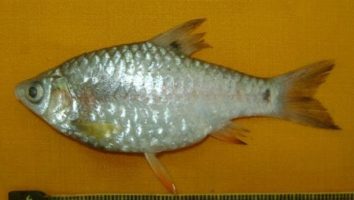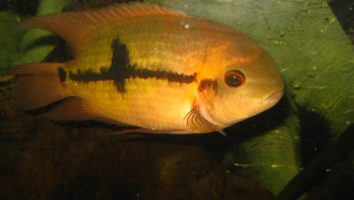The red shiner is a hardy and peaceful freshwater fish that makes a great addition to any community tank.
Despite their small size, these fish have a lot of personality and are always active. They’re also very easy to care for, which makes them ideal for beginner fishkeepers.
If you’re thinking about adding red shiners to your tank, this guide will teach you everything you need to know. We’ll go over their diet, tank mates, lifespan, and more!
Table of contents
Species overview
The red shiner (Cyprinella lutrensis) is a species of freshwater fish that is native to the southern United States.
They are most commonly found in the Mississippi River basin, but their range extends as far east as the Mobile Basin in Alabama and as far west as the Rio Grande in Texas.
Red shiners are relatively small fish, with adults typically reaching a maximum length of around 4 inches.
As their name suggests, red shiners are characterized by their red hue. However, their coloration can vary somewhat, with some individuals appearing more orange or yellow.
Red shiners are primarily herbivorous, feeding on algae, aquatic plants, and small invertebrates.
They are a popular choice for use as bait fish, as they are relatively easy to catch and can be kept alive in bait tanks for extended periods of time.
Red shiners are also a popular aquarium fish, and they are often used in community tanks due to their peaceful nature.
Appearance

The Red shiner is a very colorful freshwater fish that is, you guessed it, red! This color can vary from a light pink to a deep red, but it is always some shade of red.
The body of the Red shiner is long and thin with a torpedo-like shape. This gives them great speed and agility in the water.
The dorsal fin of the Red shiner is short and starts about two-thirds of the way back on the body. The anal fin is of a similar size and shape and starts just before the halfway point.
The pectoral fins of the Red shiner are large and paddle-like. This helps them to maneuver quickly in the water.
The caudal fin of the Red shiner is forked and symmetrical.
The Red shiner has large eyes and a small mouth. The mouth is lined with small, sharp teeth.
Lifespan
The red shiner (Cyprinella lutrensis) is a small freshwater fish in the carp family. It is native to the southern United States but has been introduced to other parts of the country. The red shiner can live for up to 4 years in captivity.
Size
The average red shiner size is between 3 and 4 inches long. However, they can grow to be up to 6 inches long in some cases.
Tank
Tank Size
The recommended tank size for red shiners is 30 gallons. This is assuming you’re keeping them in a school of at least 5 or 6 fish (which you should).
We personally recommend a slightly larger tank if you can accommodate it. Every extra space will make a big difference and allow you to keep a larger school or more tank mates if you’re interested in a community tank.
Water Parameters
The Red Shiner is a very hardy fish that can live in a wide range of water conditions. They are found in rivers, streams, and lakes all across North America.
This gives them a wide range of water conditions that they can tolerate. The key is to provide consistent water parameters. They can acclimate to a new environment relatively quickly, but sudden changes can be stressful.
Here are some general guidelines for Red Shiner care.
- Water temperature: 50 to 70 degrees Fahrenheit
- pH levels: 6.5 to 7.5
- Water hardness: 2 to 12 dGH
- Alkalinity Levels: 4-8 dKH
What To Put In Their Tank
The ideal set up for a red shiner tank is one that is heavily planted with plenty of hiding places.
Red shiners are a schooling fish, so they will feel more comfortable and less stressed if they have plenty of places to hide.
Java fern, hornwort, and water wisteria are all great plants to include in their tank.
As for the substrate, we recommend using a sand or gravel mix. Something too fine can be difficult for these fish to swim in and something too coarse can be uncomfortable.
In terms of decorations, rocks, caves, and driftwood are all great options. Avoid anything too small or delicate that could be easily broken.
Red shiners are known to be pretty active fish, so make sure there is plenty of open swimming space in their tank.
Common Diseases
Red shiners are a hardy fish, and as such they don’t really fall ill often. However, there are a few diseases that they are susceptible to.
The most common one is definitely ich. This is a parasite that can affect any fish, and it’s especially common in freshwater tanks.
It presents itself as white spots on the body, fins, and gills of your fish. If left untreated it can be fatal, so it’s important to act fast when you see the symptoms.
The other disease that you might see in your red shiner is Hole in the Head disease. This is most commonly caused by poor water quality, and it presents itself as… you guessed it, holes in the head of your fish.
It’s a pretty gruesome disease, but it’s also fairly easy to cure. Just improve the water quality in your tank and the holes should start to heal up on their own.
Of course, the best way to prevent these diseases is by simply keeping your tank clean and your fish healthy. A well-maintained tank is the key to happy and healthy fish.
Behavior & Temperament
The red shiner is a peaceful and active fish that does best in schools. They are known for being very active swimmers and will often be seen swimming near the surface of the water.
While they are peaceful fish, they can be a bit nippy. They may nip at the fins of other fish and can be aggressive towards slow-moving fish.
Red shiners are also known to be jumpers. They have been known to jump out of aquariums, so it is important to have a lid on your tank.
Tank Mates
Red shiners are schooling fish, so they need to be kept in groups of at least six. It’s best to keep them with other peaceful fish that occupy different levels of the water column.
With that in mind, here are some compatible tank mates for red shiners:
- Guppies
- Platies
- Mollies
- Swordtails
- Neon Tetras
- Weather Loach
- Clown Loach
- Cherry Shrimp
- Ghost Shrimp
Breeding
The red shiner is a North American freshwater fish that is relatively easy to breed. They are a sexually dimorphic species, which means that males and females look different from each other.
The easiest way to tell them apart is by looking at their fins. Males have much longer fins than females. In addition, the males’ fins are often brighter and more colorful.
To breed red shiners, start by setting up a breeding tank. It should be at least 20 gallons in size. Then, add some live plants and some hiding places. Driftwood is a good option.
You will also need to adjust the water parameters. Red shiners prefer water that is on the alkaline side. Aim for a pH of 7.5 to 8.5. The water should also be soft, with a hardness of 10 degrees or less.
As for temperature, these fish like it on the cooler side. Aim for 68 to 72 degrees Fahrenheit.
When everything is set up, add two females for every male. The males will start to court the females and establish their territories.
Once the pairs have been formed, the females will lay their eggs. The males will then fertilize them. After that, it’s just a waiting game. The eggs will hatch in about a week.
You can remove the adults at this point. The fry will be able to fend for themselves. Just make sure to provide them with plenty of live food.
Conclusion
The red shiner is a great fish for anyone looking for a hardy and low-maintenance fish. They’re also a good choice for those who want a colorful fish that won’t break the bank.
Overall, we think the red shiner is a great fish for both beginners and experienced fishkeepers alike.
Do you have any experience with red shiners? We’d love to hear about it in the comments below!












